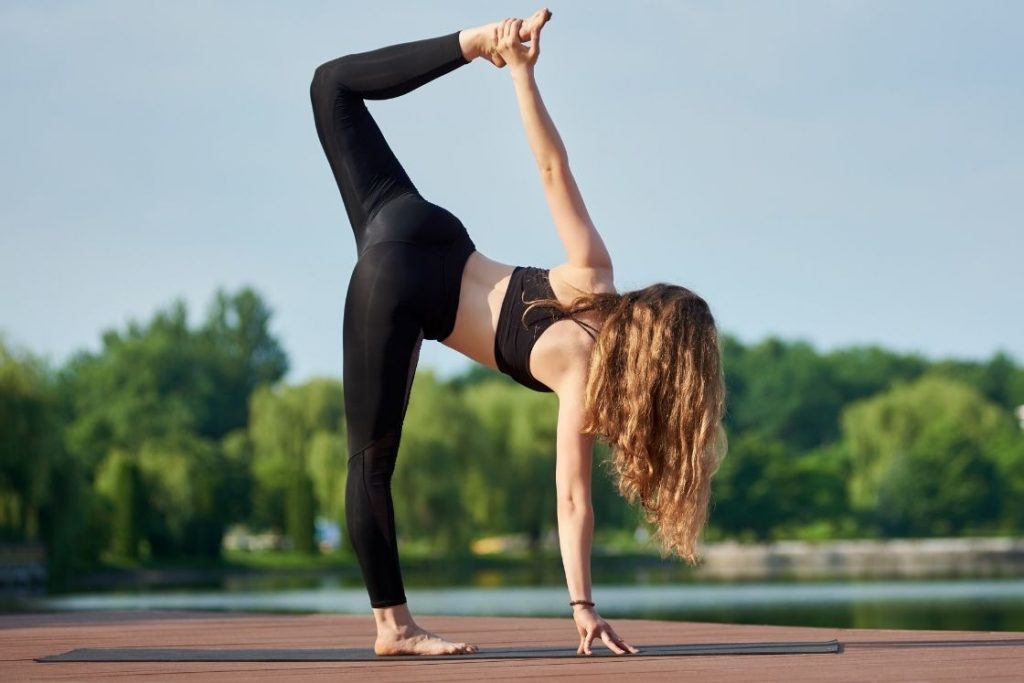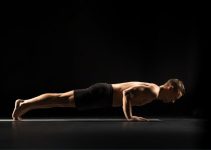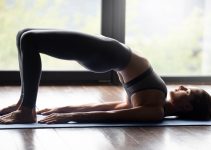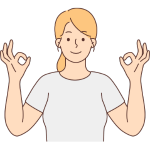
Practicing balancing yoga poses is important to have a healthy all-round workout. Balancing asanas have been significant in bringing a number of physical and mental benefits.
One such important balancing pose is Ardha Chandra Chapasana or Sugarcane Pose. The pose mainly aims to maintain and enhance body balance, leading to higher flexibility as well as enhanced focus.
In Ardha Chandra Chapasana, ‘ardha’ means half, ‘chandra’ means the moon, ‘chap’ means a bow, and ‘asana’ means posture. Thus it’s also called Half Moon Bow Pose.
Ardha Chandra Chapasana popularly known as Sugarcane pose as in this pose the body takes the shape like sugarcane. The other name of this asana is Candy Cane Pose. Ardha Chandra Chapasana is actually an advanced variation of Ardha Chandrasana or half-moon pose.
Ardha Chandra Chapasana is considered most useful for strengthening your lower part of the body, as well as offering flexibility to your shoulders and spine. Since it is a balancing posture, the practice of sugarcane pose is also good for enhancing your ability to concentrate.
Sugarcane Pose Practice Guide
As it is an intermediate and advanced level asana, Ardha Chandra Chapasana should be practised ensuring some important factors.
Contraindications
- Avoid the practice of sugarcane pose if you have an injury in your ankles, hips, knees, or lower back.
- People having low blood pressure, diarrhea, headaches, or frequent dizziness should avoid practicing sugarcane posture.
- Since it is a balancing pose, pregnant women are suggested to avoid sugarcane pose.
- People who have had a neck injury or any trouble twisting the neck are advised to look straight ahead in the final posture.
Preparatory Poses
To warm up lower body limbs before sugarcane pose, do these preparatory poses;
- Trikonasana (Triangle Pose)
- Parivarta Trikonasana (Bound Extended Side Angle)
- Virabhadrasana III (Warrior Pose III)
- Ardha Chandrasana (Half Moon Pose)
- Natarajasana (Dancer Pose)
- Parivarta Ardha Chandrasana (Revolved Half Moon Pose)
How to Do Sugarcane Pose
- Stand in Tadasana, joining your feet together, keeping your back and neck straight.
- Now, exhale, move your right feet to the front and place it about 3-4 feet away from your left feet.
- You can take the distance according to your comfort, ensuring your hip is opening when you are placing the right feet away in the front.
- Lean forward and place your right palm ahead of the right feet. Feel the stretch in your spine as you bend forward.
- At the same time, lift your left leg upwards and bring it parallel to the ground.
- Now raise your left arm and bring it in line with the right arm. Your hands should be in a straight line.
- Now gently fold your left leg from the knee and hold it with your left hand.
- Maintaining the balance of your body on the right leg and right hand, slowly stretch out your left leg and left hand outwards. Look upwards at your left palm.
- Hold this final posture for 3 to 4 natural and stable breaths, and release it step by step.
- Stand in Tadasana, take a few deep breaths and move to the practice of the same, starting from the left leg.
Follow-up Pose
Stand straight in tadasana after sugarcane pose. Take a few deep breaths and then you can do other yoga poses.
Beginners’ Tips
In the first step of Ardha Chandra Chapasana, when you move your right foot forward, do not bend it from the knees. Ensure that it is straight and then bend from your lower back, placing your right hand forward.
While practising sugarcane posture, it is important to open up the chest. Even if you are unable to hold your left leg by the left hand, ensure your chest is not bending downwards. Lateral bending is the essence of Ardha Chandra Chapasana and hence it is important to open your chest outside, not downward.
Ardha Chandra Chapasana is an intermediate-level yoga posture. So before beginning, make sure that you have learned the preparatory postures and are stable in those.
Balancing is the key factor of this asana. Hence, at any point if you feel that you are losing your hold, slowly release the posture and relax in tadasana (standing posture).
Props and Modifications
Modifications of Ardha Chandra Chapasana can be practised by those who are unable to reach the final position of the asana or those who are advised to vary the practice by the yoga teacher.
Ardha Chandra Chapasana (neck in the front)
In this variation, a person is asked to keep his neck steady and look at the front in the final posture. Sometimes, it can be advised to be able to maintain the balance better. This variation is also good for people who have neck pains.
Ardha Chandra Chapasana using block
For some people, it becomes hard to keep the knee straight while bending forward and touching the palm on the ground. Such practitioners can use a block and place their palm on the block so the knee remains straight.
This variation is also useful for practitioners who have slight back pain and cannot fully bend from their lower back.
Ardha Chandra Chapasana using strap
This variation is for those people who cannot raise their leg up and hold it with their hand. For this, they can use a strap and with its support can stabilize their leg upwards. In this condition, the upper hand will try to hold the upper leg, which is tied to a strap.
Ardha Chandra Chapasana using chair
Those who cannot bend keeping their knees straight or those who have problem bending from the lower back can use a chair to support the lower hand. Instead of keeping your palm on the floor, keep it on the chair creating a 90-degree angle with your shoulder.
Rest the posture of the upper leg and hand will be the same. Hold the upper leg with the upper hand and look toward the ceiling.
Variation
This variation of Sugarcane Pose is meant to enhance its benefits and bring dynamism to your practice.
Parivarta Ardha Chandra Chapasana (Revolved sugarcane pose)
In revolved sugarcane pose, instead of touching the same right palm to the ground, you lower the left palm in front of your right leg. Next, you raise your left leg up and hold its ankle with your right hand and stretch both out in the upward direction. This completes the posture of parivarta ardha chadra chapasana. After 4-5 natural breaths, you can release the posture and practice the same from the other side.
Sugarcane Pose Benefits
1. Makes Lower Body Flexible
The posture of Ardha Chandra chapasana makes use of your entire lower body parts and stretches them. Its practice leads to expansion of the hips, thighs, calves, and hamstrings.
Stretch in these parts of the lower body results in better flexibility and strength. It is an intermediate practice that benefits from making your legs fit.
2. Stretches the Spine
Ardha Chandra chapasana stretches your spine and enhances its function. We as humans are capable of doing wonderous activities as a result of our erected spine. This asana stretches the spine and makes it flexible, resulting in lesser spinal problems.
3. Improves Full Body Coordination
The sugarcane pose requires balancing the body with one leg and one hand. This posture brings entire body coordination so the practitioner can remain stable in the asana. This posture brings your awareness to multiple organs of your body and improves your coordination.
4. Opens the Rib Cage and Abdominal Muscles
The key point of the sugarcane pose is to open up your chest. This helps open the ribcage so that you can breathe better. The capacity of your lungs is increased when your ribcage opens.
Ardha Chandra Chapasana is also beneficial for your abdominal muscles. It puts pressure on them, reducing the fat cells and improving the capacity of the abdominal muscles.
5. Enhances Balance and Focus
The practice of Ardha Chandra Chapasana offers a number of mental benefits too. As it is a balancing pose, you have to concentrate on maintaining the balance. This helps focus your mental resources on one task of body coordination, thereby improving your mental balance and focus as well.
Final Thoughts
Balancing poses like the sugarcane pose are very much necessary to make your yoga workout all-encompassing. It offers a wide range of benefits from strengthening your legs and spine to developing your attention.
Its raising posture is a challenging one and requires steady yet regular practice. If you include such challenging postures to your exercises, it will no doubt become dynamic, exciting, and beneficial for your yogic progress.




 Oct 24th to 30th
Oct 24th to 30th Learn Mudras
Learn Mudras  Deepen Your Practice
Deepen Your Practice  Find Inner Peace
Find Inner Peace